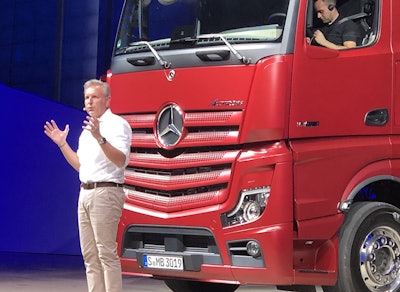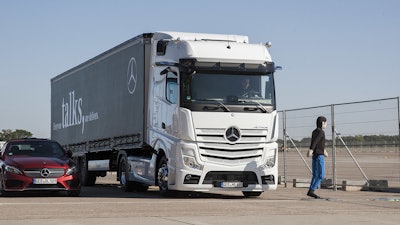
On the eve of IAA 2018, the world’s largest commercial vehicle show in Hannover, Germany, Daimler Trucks introduced the new Mercedes-Benz Actros. More than just a vehicle refresh, Daimler says the production-series cabover is the realization of its Future Truck 2025 initiative rolled out four years earlier.
The Future Truck’s fingerprints indeed are all over the new Actros, which boasts more than 60 new intelligent system features and four industry-firsts for production vehicles: a digital multimedia cockpit, semi-autonomous driver assistance, active braking on pedestrians and camera-based sideview monitoring.
Regulations, size and weight restrictions, geography and customer needs clearly separate the new Actros from its Freightliner Cascadia sibling in North America, but Daimler consistently has demonstrated a willingness to introduce new truck features in other markets when demands and customer needs change. Here is a closer look at some of the major announcements of the new Actros:
MirrorCam
While current Federal Motor Carrier Safety Administration regulations require physical exterior side-view mirrors on trucks operating in the United States, new European regulations passed earlier this summer allow Daimler to replace conventional mirrors with MirrorCam, a new system that uses external cameras on the new Actros to display truck surroundings on two 15-inch displays mounted to the A pillars. A standard feature on the new Actros, MirrorCam is designed to increase overall side visibility and Daimler says the elimination of conventional mirrors improves aerodynamics and enhances diagonal visibility past the A pillars.
 Stefan Buchner, head of Mercedes-Benz Trucks, touts the features of the new Actros at a special media event in Hannover, Germany.
Stefan Buchner, head of Mercedes-Benz Trucks, touts the features of the new Actros at a special media event in Hannover, Germany.“The MirrorCam increases the safety and aerodynamic efficiency,” said Gorden Wagener, chief design officer for Daimler AG. “I’m glad we were able to transform the new Actros into the digital age.”
MirrorCam also displays virtual distance lines to assist the driver when steering in reverse and backing to a loading dock. A customizable reference line, such as one to represent the end of the trailer, can be added for more precise maneuvering applications.
Active Drive Assist
Building on the stop-and-go and lane keep assist functions in the current Actros, the new Actros’ Active Drive Assist system delivers SAE Level-2 automated driving with the addition of autonomous control of the distance between the truck and the forward vehicle as well as automatic lane guidance that combines camera-based active lane tracking with corrective steering.
“Active Drive Assist can maintain the vehicle in the lane at all speeds to support drivers on long-distance roads and traffic jams, making the new Actros the first to do so in our industry,” said Stefan Buchner, head of Mercedes-Benz Trucks, adding the driver must still have his hands on the wheel at all times. “Active Drive Assist significantly reduces the risk of accidents and the costs of a vehicle leaving its lane. It is a huge step forward in terms of safety.”
Active Brake Assist 5
 The new Actros is equipped with Active Brake Assist 5, the newest generation system that allows full braking on pedestrians.
The new Actros is equipped with Active Brake Assist 5, the newest generation system that allows full braking on pedestrians.The new Active Brake Assist 5 system, which uses a Bendix-like camera and radar combination for object detection, now offers full emergency braking on pedestrian detection up to 50 kmph (32 mph). The camera and radar system has a pedestrian detection range of 80 to 100 meters in normal weather conditions, compared to 250 meters for vehicle detection.
The system also updates the 2016-introduced Sideguard Assist, a feature that now alerts the driver to pedestrians and cyclists in addition to cars using two radar sensors mounted near the truck’s rear axle on the right side to provide audible, visual and haptic warnings. Mercedes-Benz says it soon will offer active braking in conjunction with its Sideguard Assist system.
Multimedia cockpit
Behind the wheel, the new Actros’ cockpit is a near carbon copy of the Future Truck 2025 concept. A large driver display with capacitive-touch controls mounted on the steering wheel replaces the traditional instrument cluster and gauges. A second display with touchscreen capability to the driver’s right side replaces many of the non-critical physical switches and buttons from the previous-generation Actros, including media, navigation, phone and climate control, using the new Mercedes-Benz User Experience (MBUX) platform.
“We have placed 80 percent of all use cases in the first two [screens],” said Wagener of the MBUX interface.













